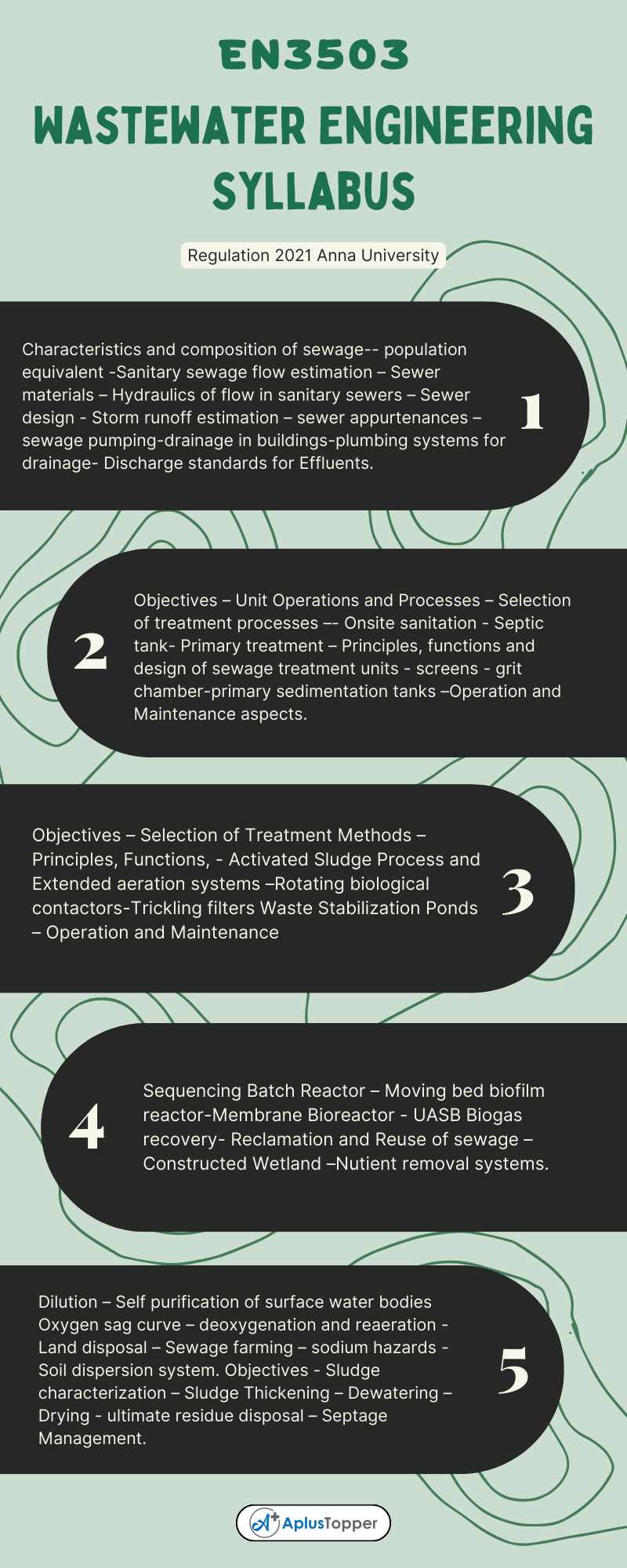EN3503 subject code deals with the Wastewater Engineering syllabus of B.E Environmental Engineering. In the second year, it is included in the semester V. This subject deals with the statistics and probability concepts to explore. In this article, we include textbooks and references to guide you to some more extent.
We aim to provide a detailed syllabus of EN3503 Wastewater Engineering. You can find unit-wise concepts and can easily make your preparations for examinations. It wouldn’t be difficult to find all the requirements in one place for the subject syllabus. This motto makes us provide this information to make it easy for you. Hope this information is useful. Don’t regret to share it with your classmates.
If you want to know more about the syllabus of other branches including B.E Environmental Engineering connected to an affiliated institution’s four-year undergraduate degree programme. We provide you with a detailed Year-wise, semester-wise, and Subject-wise syllabus in the following link B.E Environmental Engineering Syllabus Anna University, Regulation 2021.
Aim Of Concept:
- The objectives of this course is to help students develop the ability to apply basic understanding of physical, chemical, and biological phenomena for successful design, operation and maintenance of sewage treatment plants.
EN3503 – Wastewater Engineering Syllabus
Unit I: Planning And Design Of Sewerage System
Characteristics and composition of sewage– population equivalent -Sanitary sewage flow estimation – Sewer materials – Hydraulics of flow in sanitary sewers – Sewer design – Storm runoff estimation – sewer appurtenances – sewage pumping-drainage in buildings-plumbing systems for drainage- Discharge standards for Effluents.
Unit II: Primary Treatment Of Sewage
Objectives – Unit Operations and Processes – Selection of treatment processes –- Onsite sanitation – Septic tank- Primary treatment – Principles, functions and design of sewage treatment units – screens – grit chamber-primary sedimentation tanks –Operation and Maintenance aspects.
Unit III: Secondary Treatment Of Sewage
Objectives – Selection of Treatment Methods – Principles, Functions, – Activated Sludge Process and Extended aeration systems –Rotating biological contactors-Trickling filters Waste Stabilization Ponds – Operation and Maintenance
Unit IV: Advances In Sewage Treatment
Sequencing Batch Reactor – Moving bed biofilm reactor-Membrane Bioreactor – UASB Biogas recovery- Reclamation and Reuse of sewage – Constructed Wetland –Nutient removal systems.

Unit V: Sewage Disposal And Sludge Management
Dilution – Self purification of surface water bodies Oxygen sag curve – deoxygenation and reaeration – Land disposal – Sewage farming – sodium hazards – Soil dispersion system. Objectives – Sludge characterization – Sludge Thickening – Dewatering – Drying – ultimate residue disposal – Septage Management.
Textbooks:
- Garg, S.K., Environmental Engineering Vol. II, Khanna Publishers, New Delhi, 2015.
- Duggal K.N., “Elements of Environmental Engineering” S.Chand and Co. Ltd., New Delhi, 2014.
- Punmia, B.C., Jain, A.K., and Jain. A.K.., Environmental Engineering, Vol.II, Laxmi Publications, 2010.
References:
- Manual on Sewerage and Sewage Treatment Systems Part A, B and C, CPHEEO, Ministry of Urban Development, Government of India, New Delhi, 2013.
- Metcalf and Eddy- Wastewater Engineering–Treatment and Reuse, Tata Mc.Graw-Hill Company, New Delhi, 2010.
- Syed R. Qasim “Wastewater Treatment Plants”, CRC Press, Washington D.C.,2010
- Gray N.F, “Water Technology”, Elsevier India Pvt. Ltd., New Delhi, 2006.
Must Read:
Anna University Syllabus 2021
Related Posts On Semester – V:
- EN3501 Soil Mechanics and Foundation Engineering
- EN3502 Life Cycle Assessment
- EN3511 Environmental Engineering Laboratory
- EN3512 Environmental Engineering Design and Drawing
